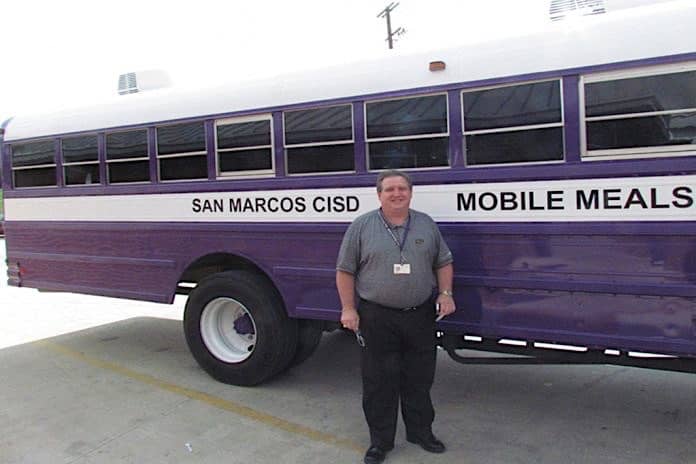For many children, summer vacation means a carefree break from school, bringing beach visits, pool parties and popsicles. But for other children across America, summer also means not having access to the meals they receive on school days. The breakfast and lunch served at school may be the only meals they eat on a given day.
Many school districts offer summer meal programs to ensure that these children do not go hungry. Of these, several are also incorporating a mobile aspect to their programs by transporting food, often in school buses, to various locations in low-income neighborhoods. Some of these school districts are San Marcos Independent School District in Texas, the Lebanon Community School District in Oregon, and the Anne Arundel County Public Schools, among others.
San Marcos ISD’s lunch program originally served meals at school campuses, and in 2010 expanded to include other community sites to facilitate access to those who lacked transportation.
Mike Boone (pictured, above), assistant director of Child and Nutrition Services at San Marcos ISD, said the mobile aspect of the summer lunch program came about in 2012 after he realized many children had no way of getting to the locations where the food was being served, even with the added sites.
“There weren’t a whole lot of kids, and it just kind of came to me: ‘Why don’t we get a bus?’ Because the first trailer park that we go to is probably 20 miles from the nearest school. Even if they do have transportation, that’s a long haul. A lot of them are in bad economic shape and a lot of people don’t have cars,” he told STN.
The district then found an older, retired school bus with child nutrition funds and started a retrofitting process that lasted approximately five months.
“It wasn’t air conditioned so we put air conditioning in, because the kids have to get on the bus and eat. Our colors are purple and white, so we painted it. We put a gas generator so that when the bus is stopped, the generator runs the air conditioning unit, ” he added.
Three rows of seats were also removed from the back to make space for a cooler, an insulated warmer and other necessary equipment.
The summer meals program at the Lebanon Community School District also retrofitted a school bus to deliver lunch to children who need it. Angie Gorman, the district’s nutrition services director, said that the process took about three months and that “mechanics and maintenance staff did the work on the bus in between their other work.”
Similar to San Marcos ISD, this summer meals program was operating at different campuses for many years, but Gorman discovered a need to bring the meals to kids who could not come to them.
“We needed to find a way to serve students in our southern end of town. There were no parks to be used there. And we needed to come up with creative way to feed them,” she said.
After some internet research, the idea of using a school bus to transport meals was born, and this summer marked the first year of the mobile meals program at the district.
Gorman used her creativity to not only figure out how to bring meals to the children, but also to think of a way to obtain the funding needed to make it happen.
“I applied for grants from the Partners for a Hunger-Free Oregon, and they helped us with the grant for labor to staff the bus during the summer. Then I applied for a summer grant through our Department of Education, and part of that grant was for the graphics on the bus,” she said.
Gorman added that the bus stops at two different locations and served about 30 meals per day. The menu includes a hot entree, such as spaghetti, with fruits, vegetables and milk provided with every meal.
The menu options at San Marcos ISD are similar, an example being a whole-grain burrito entree, also with fruits, vegetables, and milk, Boone said. This summer, the school bus stopped at four different sites around the community and served an average of 75 to 90 lunches each day.
“They get a nutritious meal, and if they didn’t have that option, it would probably be a 99-cent double cheeseburger,” he noted. “When times are hard, to eat healthy is expensive,”
Boone added that the community has expressed appreciation for the program.
“We had a grandma say, ‘I’ve got my three grandkids here in the summer. I don’t have a car. If they didn’t come out here, some days I don’t know what I’d be feeding them,’” he said.
In fact, the response has been so positive that other nearby districts are “stealing the ball on the idea,” according to Boone.
“I don’t mind. We should all be helping the kids eat. That’s what we’re here for,” he said.
















